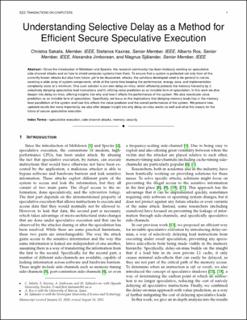| dc.contributor.author | Sakalis, Christos | |
| dc.contributor.author | Kaxiras, Stefanos | |
| dc.contributor.author | Ros, Alberto | |
| dc.contributor.author | Jimborean, Alexandra | |
| dc.contributor.author | Själander, Magnus | |
| dc.date.accessioned | 2021-02-25T13:11:05Z | |
| dc.date.available | 2021-02-25T13:11:05Z | |
| dc.date.created | 2020-08-14T08:06:20Z | |
| dc.date.issued | 2020 | |
| dc.identifier.citation | IEEE transactions on computers. 2020, 69 (11), 1584-1595. | en_US |
| dc.identifier.issn | 0018-9340 | |
| dc.identifier.uri | https://hdl.handle.net/11250/2730441 | |
| dc.description.abstract | Since the introduction of Meltdown and Spectre, the research community has been tirelessly working on speculative side-channel attacks and on how to shield computer systems from them. To ensure that a system is protected not only from all the currently known attacks but also from future, yet to be discovered, attacks, the solutions developed need to be general in nature, covering a wide array of system components, while at the same time keeping the performance, energy, area, and implementation complexity costs at a minimum. One such solution is our own delay-on-miss, which efficiently protects the memory hierarchy by i) selectively delaying speculative load instructions and ii) utilizing value prediction as an invisible form of speculation. In this article we dive deeper into delay-on-miss, offering insights into why and how it affects the performance of the system. We also reevaluate value prediction as an invisible form of speculation. Specifically, we focus on the implications that delaying memory loads has in the memory level parallelism of the system and how this affects the value predictor and the overall performance of the system. We present new, updated results but more importantly, we also offer deeper insight into why delay-on-miss works so well and what this means for the future of secure speculative execution. | en_US |
| dc.language.iso | eng | en_US |
| dc.publisher | Institute of Electrical and Electronics Engineers (IEEE) | en_US |
| dc.rights | Navngivelse 4.0 Internasjonal | * |
| dc.title | Understanding Selective Delay as a Method for Efficient Secure Speculative Execution | en_US |
| dc.type | Peer reviewed | en_US |
| dc.type | Journal article | en_US |
| dc.description.version | acceptedVersion | en_US |
| dc.source.pagenumber | 1584-1595 | en_US |
| dc.source.volume | 69 | en_US |
| dc.source.journal | IEEE transactions on computers | en_US |
| dc.source.issue | 11 | en_US |
| dc.identifier.doi | 10.1109/TC.2020.3014456 | |
| dc.identifier.cristin | 1823261 | |
| dc.relation.project | Vetenskapsrådet: 2015-05159. | en_US |
| dc.description.localcode | © 2020 IEEE. Personal use of this material is permitted. Permission from IEEE must be obtained for all other uses, in any current or future media, including reprinting/republishing this material for advertising or promotional purposes, creating new collective works, for resale or redistribution to servers or lists, or reuse of any copyrighted component of this work in other works. | en_US |
| cristin.ispublished | true | |
| cristin.fulltext | postprint | |
| cristin.qualitycode | 2 | |
